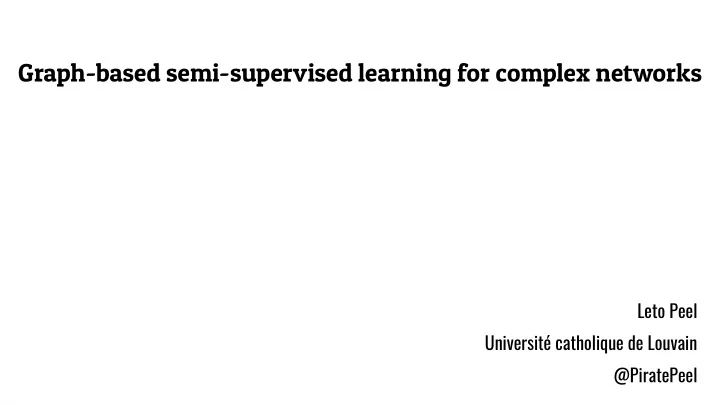

Graph-based semi-supervised learning for complex networks Leto Peel Université catholique de Louvain @PiratePeel
Here is a network social networks food webs internet protein interactions
Network nodes can have properties or attributes (metadata) Metadata values Metadata unknown social networks age, sex, ethnicity, race, etc. food webs feeding mode, species body mass, etc. internet data capacity, physical location, etc. protein interactions molecular weight, association with cancer, etc.
Network nodes can have properties or attributes (metadata) Metadata values Metadata unknown Can we predict the unknown metadata values? social networks age, sex, ethnicity, race, etc. food webs feeding mode, species body mass, etc. internet data capacity, physical location, etc. protein interactions molecular weight, association with cancer, etc.
Now, let's talk about supervised learning... Training {(X,Y)} train inference f f output input X Y Predict classification Y feature vector discrete label ~ f (X test )
f
Now, let's talk about semi- supervised learning... Training {(X,Y)} train inference f f output input X Y use all available data for training the classifier Predict classification Y feature vector discrete label ~ f (X test ) X test
Graph-based semi-supervised learning Construct a graph based on similarity in X and propagate label information around the graph
Semi-supervised learning in complex networks Metadata values Metadata unknown
Semi-supervised learning in complex networks assortative Metadata values Metadata unknown
Semi-supervised learning in complex networks assortative disassortative Metadata values Metadata unknown
Semi-supervised learning in complex networks assortative disassortative mixed Metadata values Metadata unknown
Semi-supervised learning in relational networks assortative disassortative mixed Metadata values Metadata unknown
Semi-supervised learning in relational networks assortative disassortative mixed Metadata values Metadata unknown
Semi-supervised learning in relational networks assortative disassortative mixed Metadata values Metadata unknown
Naive application of label propagation does not work if we don't know how classes interact
Naive application of label propagation does not work if we don't know how classes interact Solution: Construct a similarity graph based on the relational network
Structurally equivalent nodes Lorrain & White, Structural equivalence of individuals in social networks. J. Math. Sociol., 1971
Common neighbours cosine similarity is a measure of how structurally equivalent two nodes are cosine label propagation
Neighbours of neighbours the set of neighbours of a node's neighbours contain all structurally equivalent nodes two-step label propagation
Why are paths of length 2 important? presence of triangles in assortative relations bipartite / diassortative negative auto-correlation Gallagher et al. Using ghost edges for classification in sparsely labeled networks, KDD 2008
Why are paths of length 2 important? Label propagation is an eigenvector problem has eigenvalues in [-1,1] most positive most negative
Why are paths of length 2 important? Label propagation is an eigenvector problem has eigenvalues in [-1,1] When we consider even path lengths using L 2 (or A 2 in the case of cosine LP) the eigenvectors remain unchanged, but the eigenvalues are all positive positive positive
Gratuitous Comp. Sci. “My curve is better than your curve” slide
Take home messages... 1) Complex networks are not (necessarily) the same as similarity graphs we should adapt our methods accordingly •
Take home messages... 1) Complex networks are not (necessarily) the same as similarity graphs we should adapt our methods accordingly • 2) Machine Learning for Complex Networks does not require representing nodes as feature vectors use Network Science! •
Advertisement Applications now open! http://wwcs2019.org/ February 4-8 th 2019 Zakopane, Poland
For more information... Peel, Graph-based semi-supervised learning for relational networks. SIAM International Conference on Data Mining, 2017 https://arxiv.org/abs/1612.05001 Contact: leto.peel@uclouvain.be @PiratePeel
regularisation parameter predicted labels Linear operator known labels
regularisation parameter predicted labels Linear operator known labels L = B= Initialise F=B N x C N x N 1 (or 0) if we know node (graph connectivity) belongs to class (or not) 1/C otherwise
regularisation parameter predicted labels Linear operator known labels smoothness consistency
predicted labels known labels not I – D -(1/2) AD -(1/2) since we require the “smoothest” eigenvector to be dominant (associated with the largest eigenvalue) Zhou et al. Learning with local and global consistency, NIPS 2003
predicted labels known labels Solve using the power method: Zhou et al. Learning with local and global consistency, NIPS 2003
Recommend
More recommend